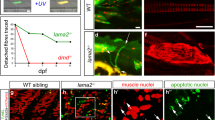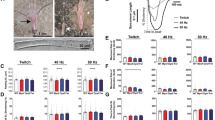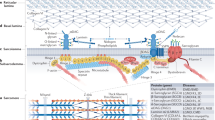Abstract
Mutations in the dystrophin gene1 (DMD) and in genes encoding several dystrophin-associated proteins result in Duchenne and other forms of muscular dystrophy2. α-Dystroglycan (Dg) binds to laminins in the basement membrane surrounding each myofibre and docks with β-Dg, a transmembrane protein, which in turn interacts with dystrophin or utrophin in the subplasmalemmal cytoskeleton. α- and β-Dgs are thought to form the functional core of a larger complex of proteins extending from the basement membrane to the intracellular cytoskeleton, which serves as a superstructure necessary for sarcolemmal integrity2. Dgs have also been implicated in the formation of synaptic densities of acetylcholine receptors (AChRs) on skeletal muscle3,4. Here we report that chimaeric mice generated with ES cells targeted for both Dg alleles have skeletal muscles essentially devoid of Dgs and develop a progressive muscle pathology with changes emblematic of muscular dystrophies in humans. In addition, many neuromuscular junctions are disrupted in these mice. The ultrastructure of basement membranes and the deposition of laminin within them, however, appears unaffected in Dg-deficient muscles. We conclude that Dgs are necessary for myofibre survival and synapse differentiation or stability, but not for the formation of the muscle basement membrane, and that Dgs may have more than a purely structural function in maintaining muscle integrity.
This is a preview of subscription content, access via your institution
Access options
Subscribe to this journal
Receive 12 print issues and online access
$209.00 per year
only $17.42 per issue
Buy this article
- Purchase on Springer Link
- Instant access to full article PDF
Prices may be subject to local taxes which are calculated during checkout





Similar content being viewed by others
References
Koenig, M. et al. Complete cloning of the Duchenne muscular dystrophy (DMD ) cDNA and preliminary genomic organization of the DMD gene in mouse and affected individuals. Cell 50, 509– 517 (1987).
Lim, L.E. & Campbell, K.P. The sarcoglycan complex in limb-girdle muscular dystrophy. Curr. Opin. Neurol. 11, 443–452 (1998).
Gee, S.H., Montanaro, F., Lindenbaum, M.H. & Carbonetto, S. Dystroglycan-α, a dystrophin-associated glycoprotein, is a functional agrin receptor. Cell 77, 675– 686 (1994).
Campanelli, J.T., Roberds, S.L., Campbell, K.P. & Scheller, R.H. A role for dystrophin associated glycoproteins and utrophin in agrin-induced AChR clustering. Cell 77, 663– 674 (1994).
Williamson R.A. et al. Dystroglycan is essential for early embryonic development—disruption of Reichert's membrane in Dag1-null mice. Hum. Mol. Genet. 6, 831–841 ( 1997).
Cohen, M.W., Jacobson, C., Yurchenco, P.D., Morris, G.E. & Carbonetto, S. Laminin-induced clustering of dystroglycan on embryonic muscle cells: comparison with agrin-induced clustering. J. Cell Biol. 136, 1047– 1058 (1997).
Henry, M.D. & Campbell, K.P. A role for dystroglycan in basement membrane assembly. Cell 95, 859– 870 (1998).
Colognato, H., Winkelmann, D.A. & Yurchenco, P.D. Laminin polymerization induces a receptor-cytoskeleton network. J. Cell Biol. 145, 619– 631 (1999).
Deconinck, A.E. et al. Utrophin-dystrophin-deficient mice as a model for Duchenne muscular dystrophy. Cell 90, 717– 727 (1997).
Grady, R.M. et al. Skeletal and cardiac myopathies in mice lacking utrophin and dystrophin: a model for Duchenne muscular dystrophy. Cell 90, 729–738 (1997).
Peterson, A.L., Frair, P.M. & Wong, G.G. A technique for detection and relative quantitative analysis of glucosephosphate isomerase isozymes from nanogram tissue samples. Biochem. Genet. 16, 681–689 (1978).
Straub, V., Rafael, J.A., Chamberlain, J.S. & Campbell, K.P. Animal models for muscular dystrophy show different patterns of sarcolemmal disruption. J. Cell Biol. 139, 375– 385 (1997).
Yoshida, M. et al. Dissociation of the complex of dystrophin and its associated proteins into several unique groups by n-octyl-D-glucoside. Eur. J. Biochem. 222, 1055–1061 (1994).
Smalheiser, N.R. & Schwartz, N.B. Cranin, a laminin-binding protein of cell membranes. Proc. Natl Acad. Sci. USA 84, 6457–6461 (1987).
Douville, P.J., Harvey, W.J. & Carbonetto, S. Isolation & partial characterization of high affinity laminin receptors in neural cells. J. Biol. Chem. 263 , 14964–14969 (1988).
Ibraghimov-Beskrovnaya, O. et al. Primary structure of dystrophin-associated glycoproteins linking dystrophin to the extracellular matrix. Nature 355, 696–702 (1992).
Bowe, M.A., Deyst, K.A., Leszyk, J.D. & Fallon, J.R. Identification and purification of an agrin receptor from Torpedo post-synaptic membranes: a heterodimeric complex related to the dystroglycans. Neuron 12, 1173–1180 ( 1994).
Sugiyama, J., Bowen, D.C. & Hall, Z.W. Dystroglycan binds nerve and muscle agrin. Neuron 13, 103–115 ( 1994).
Peng, H.B., Xie, H., Rossi, S.G. & Rotundo, R.L. Acetylcholinesterase clustering at the neuromuscular junction involves perlecan and dystroglycan. J. Cell Biol. 145, 911– 921 (1999).
Jung, D., Yang, B., Meyer, J., Chamberlain, J.S. & Campbell, K.P. Identification and characterization of the dystrophin anchoring site on β-dystroglycan. J. Biol. Chem. 270, 27305–27310 (1995).
Fritz, J.D. et al. Expression of deletion-containing dystrophins in mdx muscle: implications for gene therapy and dystrophin function. Pediatr. Res. 37, 693–700 ( 1995).
Rafael, J. et al. Forced expression of dystrophin deletion constructs reveals structure-function correlations. J. Cell Biol. 134, 93–102 (1996).
Xu, H., Christmas, P., Wu, X.-R., Wewer, U.M. & Engvall, E. Defective muscle basement membrane and lack of M-laminin in the dystrophic dy/dy mouse. Proc. Natl Acad. Sci. USA 91, 5572–5576 (1994).
Dickson, G. et al. Colocalization and molecular association of dystrophin with laminin at the surface of mouse and human myotubes . J. Cell Sci. 103, 1223–1233 ( 1992).
Montanaro, F., Lindenbaum, M. & Carbonetto, S. α-Dystroglycan is a laminin receptor involved in extracellular matrix assembly on myotubes and muscle cell viability. J. Cell Biol. 145, 1325–1340 (1999).
Montanaro F., Gee, S.H., Jacobson, C., Lindenbaum, M.H. & Carbonetto, S. Laminin and α-dystroglycan mediate acetylcholine receptor aggregation via a MuSK-independent pathway. J. Neurosci. 18, 1250–1260 ( 1998).
Cartaud, A., Coutant, S., Petrucci, T.C. & Cartaud, J. Evidence for in situ and in vitro association between β-dystroglycan and the subsynaptic 43K rapsyn protein. J. Biol. Chem. 273, 11321–11326 (1998).
Ramarao, M.K. & Cohen, J.B. Mechanisms of nicotinic acetylcholine receptor cluster formation by rapsyn. Proc. Natl Acad. Sci. USA 95, 4007–4012 ( 1998).
Peters, M.F., Kramarcy, N.R., Sealock, R. & Froehner, S.C. β2-Syntrophin: localization at the neuromuscular junction in skeletal muscle. Neuroreport 5, 1577– 1580 (1994).
Burden, S.J. The formation of neuromuscular synapses. Genes Dev. 12, 133–148 (1998).
Karnovsky, M.J. & Roots, L. A "direct-coloring" thiocholine method for cholinesterases. J. Histochem. Cytochem. 12, 219–221 ( 1964).
Acknowledgements
We thank A. Peterson, J.-P. Julien and F. Montanaro for advice and suggestions; B. Mankoo and P.P. Pandolfi for reagents; and C. Jacobson, J. Altares, Q. Zhu and D. Houle for technical assistance. This work was supported by grants to S.C. from the Muscular Dystrophy Association (USA) and the Medical Research Council of Canada.
Author information
Authors and Affiliations
Corresponding author
Rights and permissions
About this article
Cite this article
Côté, P., Moukhles, H., Lindenbaum, M. et al. Chimaeric mice deficient in dystroglycans develop muscular dystrophy and have disrupted myoneural synapses. Nat Genet 23, 338–342 (1999). https://doi.org/10.1038/15519
Received:
Accepted:
Issue Date:
DOI: https://doi.org/10.1038/15519
This article is cited by
-
NAD+ improves neuromuscular development in a zebrafish model of FKRP-associated dystroglycanopathy
Skeletal Muscle (2019)
-
Four-week rapamycin treatment improves muscular dystrophy in a fukutin-deficient mouse model of dystroglycanopathy
Skeletal Muscle (2016)
-
Neuromuscular synaptogenesis: coordinating partners with multiple functions
Nature Reviews Neuroscience (2014)
-
O-Mannosylation and human disease
Cellular and Molecular Life Sciences (2013)



